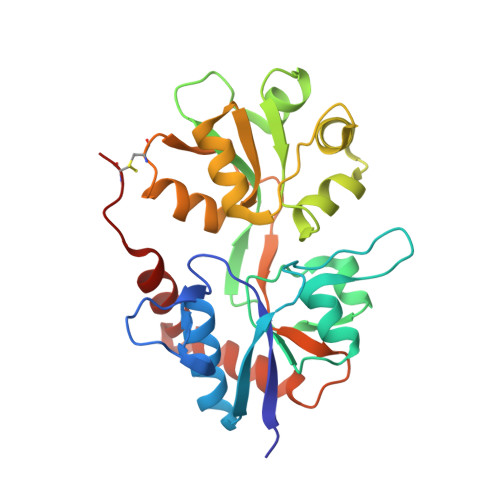Full Domain Closure of the Ligand-binding Core of the Ionotropic Glutamate Receptor iGluR5 Induced by the High Affinity Agonist Dysiherbaine and the Functional Antagonist 8,9-Dideoxyneodysiherbaine
Frydenvang, K., Lash, L.L., Naur, P., Postila, P.A., Pickering, D.S., Smith, C.M., Gajhede, M., Sasaki, M., Sakai, R., Pentikainen, O.T., Swanson, G.T., Kastrup, J.S.(2009) J Biol Chem 284: 14219-14229
- PubMed: 19297335
- DOI: https://doi.org/10.1074/jbc.M808547200
- Primary Citation of Related Structures:
3GBA, 3GBB - PubMed Abstract:
The prevailing structural model for ligand activation of ionotropic glutamate receptors posits that agonist efficacy arises from the stability and magnitude of induced domain closure in the ligand-binding core structure. Here we describe an exception to the correlation between ligand efficacy and domain closure. A weakly efficacious partial agonist of very low potency for homomeric iGluR5 kainate receptors, 8,9-dideoxyneodysiherbaine (MSVIII-19), induced a fully closed iGluR5 ligand-binding core. The degree of relative domain closure, approximately 30 degrees , was similar to that we resolved with the structurally related high affinity agonist dysiherbaine and to that of l-glutamate. The pharmacological activity of MSVIII-19 was confirmed in patch clamp recordings from transfected HEK293 cells, where MSVIII-19 predominantly inhibits iGluR5-2a, with little activation apparent at a high concentration (1 mm) of MSVIII-19 (<1% of mean glutamate-evoked currents). To determine the efficacy of the ligand quantitatively, we constructed concentration-response relationships for MSVIII-19 following potentiation of steady-state currents with concanavalin A (EC(50) = 3.6 microm) and on the nondesensitizing receptor mutant iGluR5-2b(Y506C/L768C) (EC(50) = 8.1 microm). MSVIII-19 exhibited a maximum of 16% of full agonist efficacy, as measured in parallel recordings with glutamate. Molecular dynamics simulations and electrophysiological recordings confirm that the specificity of MSVIII-19 for iGluR5 is partly attributable to interdomain hydrogen bond residues Glu(441) and Ser(721) in the iGluR5-S1S2 structure. The weaker interactions of MSVIII-19 with iGluR5 compared with dysiherbaine, together with altered stability of the interdomain interaction, may be responsible for the apparent uncoupling of domain closure and channel opening in this kainate receptor subunit.
Organizational Affiliation:
Department of Medicinal Chemistry and Pharmacology and Pharmacotherapy, Faculty of Pharmaceutical Sciences, University of Copenhagen, Universitetsparken 2, DK-2100 Copenhagen, Denmark.















